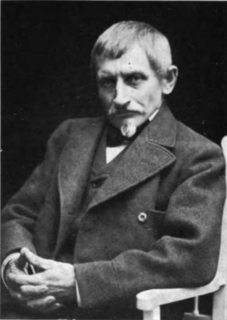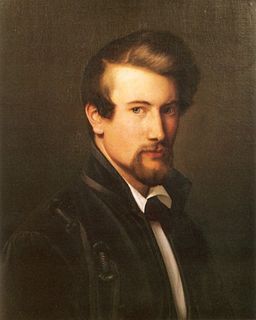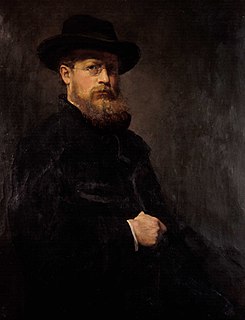
(before 1900)
Carl Fredrik Sundt-Hansen (30 January 1841, Stavanger - 27 August 1907, Stavanger) was a Norwegian-Danish genre painter; in the Romantic Nationalist style. [1] [2] [3]

Carl Fredrik Sundt-Hansen (30 January 1841, Stavanger - 27 August 1907, Stavanger) was a Norwegian-Danish genre painter; in the Romantic Nationalist style. [1] [2] [3]
Carl Sundt-Hansen was born in Stavanger, Norway. He came from an old family of wealthy merchants. He was the son of the merchant and mayor Lauritz Wilhelm Hansen (1816–1871) and his wife Elisa Margaretha Sundt (1814–1892). He adopted his mother's maiden-name (Sundt) in 1878. Originally, he was meant to take over the family business, "Plough & Sundt", but he preferred to become an artist, so he handed the business over to his younger brother, Hans Wilhelm. [1]

In 1859, he studied at the Royal Danish Academy of Fine Arts and a private school operated by Frederik Ferdinand Helsted. After two years, he transferred to the Kunstakademie Düsseldorf. He took private lessons with Swiss genre painter Benjamin Vautier. [1] In 1864, his first painting was shown at an exhibit by the Oslo Kunstforening and was well received. One of his landscapes was purchased by King Charles IV.
In 1866, he moved on to Paris; drawing inspiration from the works of Meissonier and Delaroche. [1] When King Charles visited the Exposition Universelle (1867), he awarded Carl the Order of Vasa. Carl stayed in Paris until 1871, when he returned to Norway by way of Düsseldorf. His intention was to establish a studio in Oslo, but the art market there was unpromising. He eventually came to rest in Stockholm, and remained there until 1882. [1]
That year, an economic crisis precipitated by the Paris Bourse Crash forced the family business to declare bankruptcy. The income from his paintings was insufficient, so in an attempt to improve his situation, he moved to Copenhagen. [1] His brother, Wilhelm, was financially ruined and Wilhelm's wife, artist Frida Hansen, had to be the family's support.

In 1889, Carl became a Danish citizen and was admitted to the Royal Academy as a full member. During this period, his paintings became larger and his subject matter lighter. He lived in Copenhagen until 1896, when he went back to Norway and settled in Valle. [1]
In 1907, Carl became ill with what was diagnosed as nicotine poisoning. He went to a hospital in Stavanger, where it was discovered that he had cancer. For the last few months of his life, he lived in Stavanger with his brother, Hans. [2]

Nicolai Wilhelm Marstrand, painter and illustrator, was born in Copenhagen, Denmark, to Nicolai Jacob Marstrand, instrument maker and inventor, and Petra Othilia Smith. Marstrand is one of the most renowned artists belonging to the Golden Age of Danish Painting.

Christen Dalsgaard was a Danish painter, a late student of Christoffer Wilhelm Eckersberg.

Jørgen Roed,, Danish portrait and genre painter associated with the Golden Age of Danish Painting, was born in Ringsted to Peder Jørgensen Roed and wife, Ellen Hansdatter.

Stephan Abel Sinding was a Norwegian-Danish sculptor. He moved to Copenhagen in 1883 and had his breakthrough the same year. In 1890 he obtained Danish citizenship. In 1910 he settled in Paris where he lived and worked until his death in 1922.

Adolph Tidemand was a noted Norwegian romantic nationalism painter. Among his best known paintings are Haugianerne and Brudeferd i Hardanger, painted in collaboration with Hans Gude.

Maurits Christopher Hansen was a Norwegian writer.
Olaf Helliesen Lange was a Norwegian painter and print maker. Lange's fin-de-siècle art has its own special approach visualizing the complexity of the modern urban life.

Johannes Flintoe was a Danish-born painter of Norwegian ancestry. He is known for his landscapes, costume studies and historical scenes. His works play a significant role in the transition to romantic nationalism.

Lars Hertervig was a Norwegian painter. His semi-fantastical work with motives from the coastal landscape in the traditional district of Ryfylke is regarded as one of the peaks of Norwegian painting.

For much of its history Norwegian art is usually considered as part of the wider Nordic art of Scandinavia. It has, especially since about 1100, been strongly influenced by wider trends in European art. After World War II, the influence of the United States strengthened substantially. Due to generous art subsidies, contemporary Norwegian art has a high production per capita.
Events in the year 1847 in Norway.

Hjalmar Eilif Emanuel Peterssen was a Norwegian painter. He is most commonly associated with his landscapes and portraits.

Marcus Frederik Steen Grønvold was a Norwegian painter. He painted genre scenes, historical and religious motifs and portraits was well as landscapes.

Stavanger Museum is a museum of natural and cultural history established in 1877, located in the Norwegian city Stavanger. The museum's collections consist of several departments: the department of zoology, the department for cultural history.

Eilert Adelsteen Normann was a Norwegian painter who worked in Berlin. He was a noted painter of landscapes of Norway. Normann was the artist who invited Edvard Munch to Berlin, where he painted The Scream. Normann's fjord paintings are credited with making the Norwegian fjords a more popular tourist destination.

Thomas Fearnley was a Norwegian romantic painter, a pupil of Johan Christian Dahl and a leading representative of Norwegian romantic nationalism in painting. His son Thomas Fearnley (1841–1927) founded the Fearnley dynasty of shipping magnates.

Mathias Stoltenberg was a Norwegian painter. He earned his living mostly as a travelling portrait painter and furniture restorer. His paintings were later rediscovered and presented at the 1914 Jubilee Exhibition in Kristiania.

Frida Hansen was a Norwegian textile artist in the Art Nouveau style. She Has been described as a bridge between Norwegian and European tapestry, and several of her weaving designs considered among the best made in recent European textile art. Works of Frida Hansen are in possession of a number of museums, including at the National Museum - Museum of Applied Art in Oslo, Drammen Museum, Stavanger Art Museum and the Nordic Museum in Stockholm.

Suzette Catherine Holten was a Danish painter and ceramist who belonged to the Skovgaard family of artists. In addition to landscapes, flower paintings and portraits, she created and decorated ceramics and also worked as an embroiderer. As a woman, she was unable to achieve the same level of success as her father or brothers.

Per Aass Deberitz was a Norwegian painter. He was regarded as a neo-impressionist and was also a pupil of Henri Matisse during the years of his stay in Paris from 1909 to 1910.
| Wikimedia Commons has media related to Carl Sundt-Hansen . |